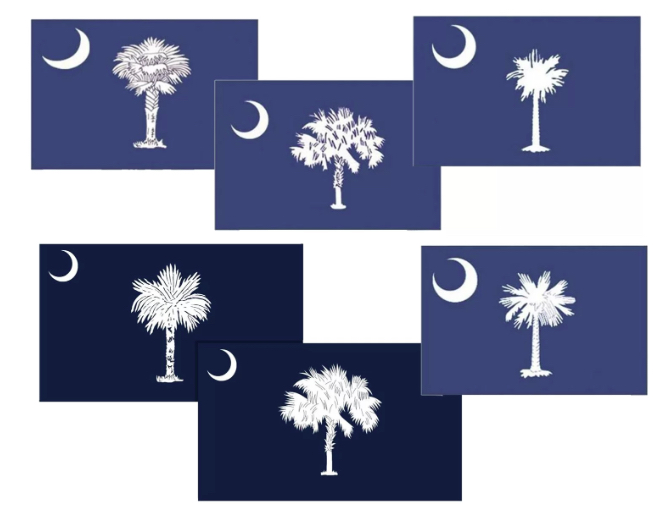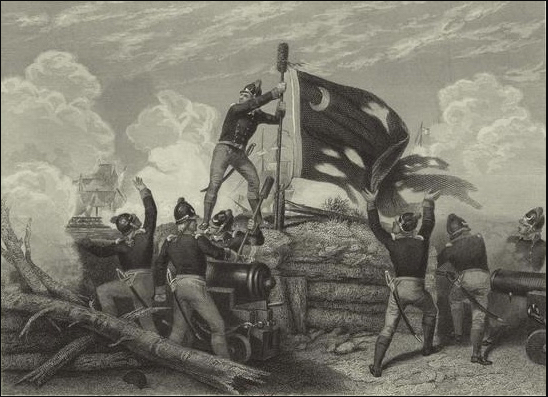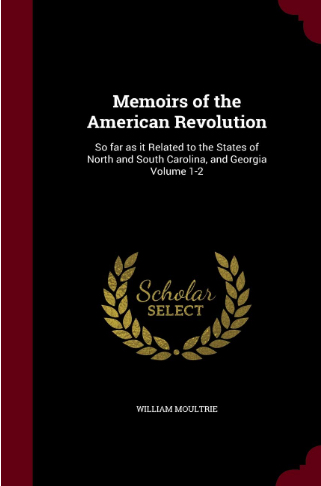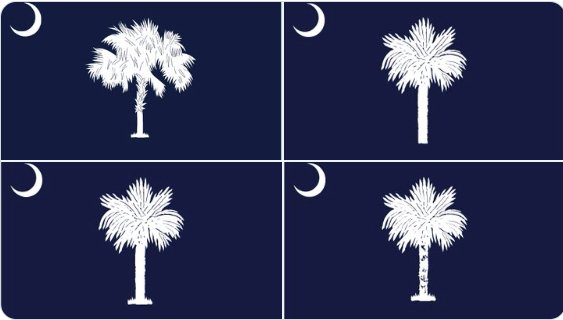HISTORY OF THE S.C.STATE FLAG
In national surveys, Americans consistently list South Carolina’s state flag among the nation’s top ten most memorable – a white palmetto tree and crescent set against an indigo blue background. Though lauded for its simple design, our flag has not been without controversy when it comes to what its symbols actually are and how they should look. Indeed, controversy continues to surround our flag today.
As often happens to historic stories, details have been forgotten or somewhat muddled through years of retelling and reinterpretation. Yet understanding the meanings behind our flag’s color, crescent, and palmetto tree help us appreciate the history, culture and values of our state, particularly when we consider how the flag’s appearance has evolved over the centuries. Let’s start at the beginning.
In 1775, as rebellious Americans moved steadily closer toward declaring war in the fight for independence from England, the patriots’ Council of Safety ordered Col. William Moultrie, commander of Fort Sullivan, to create a signal flag – a visual, physical entity – around which his troops could rally. It was a practical directive, as onlookers would know that as long as Moultrie’s flag flew, the fight was either continuing or won. Indeed, that was the impetus behind Sgt. William Jasper’s brave effort to rehoist the flag after a British ball broke its flagstaff. Jasper wanted to make sure everyone knew the fight was still on.
Moultrie’s flag featured only a white crescent in the top left corner against a blue background with the word Liberty inscribed within. Often referred to as the “Liberty” flag today, many might be surprised to learn it was first raised Sept. 13, 1775, over Fort Johnson on James Island, before it was more famously flown at Fort Sullivan in June 1776.
Some sources say the council sent Moultrie some blue cloth when they charged him with creating a flag. Others say Moultrie dyed the cloth blue, as the export of indigo dye was the state’s second largest cash crop at the time. Still others contend that the blue represented the color of Moultrie’s soldiers’ coats. More on that in a moment.
The meaning of the crescent also has long been debated. Today most people equate the crescent with a quarter moon. Yet Moultrie’s flag had the crescent’s tips curving more completely into a circular form than what we see on our flag today, deeper than one would ever see in a crescent moon.
One does see this more dramatic curving, however, in a gorget – a French term for a piece of medieval armor worn around the neck between the breastplate and helmet to protect one’s throat, which would otherwise be exposed to a sword or knife. This explanation has many adamant proponents today. A number of Revolutionary leaders wore gorgets, including William Moultrie himself, George Washington and Francis Marion. Also, Moultrie’s flag had the crescent’s opening facing upward, as would a gorget, rather than to the right or left, as seen in later versions of the flag.
To settle the debate once and for all, we must look to Moultrie’s diary to find his reasons for the flag’s color and crescent: “A little time after we were in possession of Fort Johnson [that is, late September or October 1775], it was thought necessary to have a flag for the purpose of signals: (as there was no national or state flag at that time) I was desired by the Council of Safety to have one made, upon which, as the state troops were clothed in blue, and the fort was garrisoned by the first and second regiments, who wore a silver crescent on the front of their caps; I had a large blue flag made with a crescent in the dexter corner, to be in uniform with the troops: This was the first American flag which was displayed in South Carolina.”
Toward the end of the Revolutionary War, Major Gen. Nathanael Greene declared Moultrie’s flag to be the first American flag to fly over the South. Yet this flag was never legislatively adopted as the state flag, and from then on through the early 19th century, its design began to evolve with the incorporation of an additional symbol.
As the British Navy appeared on the horizon on June 28, 1776, Moultrie’s men quickly had to compete their unfinished fort, using materials most readily at hand: palmetto logs and beach sand. Palmettos were ubiquitous along Sullivan’s beach, as their flexibility and limited foliage allow them to withstand most hurricane-force winds. The choice of materials was fortuitous, as the two armies soon learned that cannon balls fired at palmetto logs hit the soft wood with a dull thud before either being absorbed by the spongy wood or simply rolling harmlessly down to the ground after impact. In homage to Moultrie’s dramatic victory against a much larger, better supplied navy, people began adding a palmetto tree to the flag’s design.
Many versions of the flag came after that, as most were hand-painted for varying uses. Some had palmetto trees in gold or green, other replaced the crescent with stars, many used colors such red or white instead of blue as backgrounds – even as today we often see the flag flown in Clemson orange or Gamecock garnet.
Things began to get more organized, however, as the nation headed into its second war of rebellion in 1860, when South Carolina seceded from the Union. According to the South Carolina Encyclopedia, “In December 1860, when South Carolina seceded from the Union, Representative Plowden C. J. Weston called for the appointment of a joint committee to devise a South Carolina national flag or ensign. Exactly one month later the committee introduced a resolution creating a white flag with a green palmetto tree in the center and a blue union with a white crescent. Representative Robert Barnwell Rhett, Jr., amended the resolution to read ‘the National Flag or Ensign of South Carolina shall be blue with a white palmetto tree upright thereon, and a white crescent in the upper corner.’ Rhett reasoned that the colonial flag of blue with a white crescent and the white palmetto tree addition created a simple, beautiful flag. Not all of the legislators agreed with Rhett, however, and for seven days debate occurred in the House, the Senate, and the newspapers. Finally, on January 28, 1861, Rhett’s design was approved, and the blue flag with a white palmetto tree centered and a white crescent with horns pointing upward in the corner became the official state flag.”
That pretty much remained its design until President William Howard Taft’s visit in 1909, when the state’s Secretary of the Historical Commission Alexander Samuel Salley Jr., “touched up” the flag’s design by angling the crescent – for reasons that are lost to us today – with its opening to the northwest, toward the staff rather than upward as Moultrie’s had been. He also “fluffed up” the palmetto tree a bit.
In 1939, South Carolina adopted the palmetto as the state tree. A year later, the General Assembly adopted a version of the flag similar to that which we know today, though details were lacking, such as the size of the tree’s trunk or shape of its fronds. The position, placement, size, and color of the symbols vary at the discretion of the flag’s manufacturer.
That is, until a political consultant brought lack of standardization to the General Assembly’s attention in 2018. An “official” design was submitted to the legislature in 2020, though it was immediately decried by the public as the worst choice of those under consideration. Two subsequent designs have since been put before the Assembly, but by the close of the 2023/24 legislative session, no decision had been reached.
Yet despite the small differences in its design details, the South Carolina state flag continues to stand as a proud reminder of the resilience and strength of Moultrie’s troops at Fort Sullivan – as well as that of South Carolina itself.



The flag created by Col. William Moultrie in 1775.







